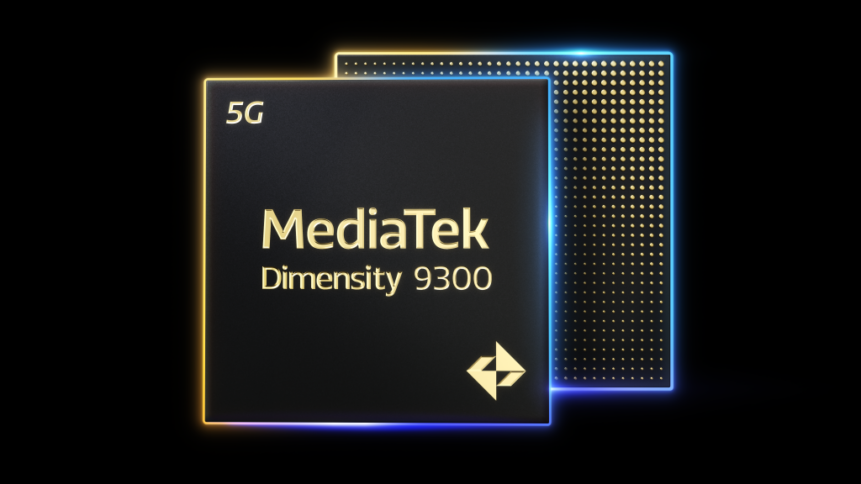MediaTek goes all-big on cores for Dimensity 9300 smartphone chip

|
Getting your Trinity Audio player ready...
|
There are a lot of factors to consider when it comes to choosing a smartphone, and bringing everything together is the chipset inside the handset. And so whenever a new mobile processor hits the market, which happened this week with the release by MediaTek of its Dimensity 9300 smartphone chip, it’s worth considering what this means for consumers.
Contrary to what marketing materials may suggest, there’s no such thing as the perfect processor for mobile devices. Instead, it’s about finding a sweet spot. Chip designers must maximize performance while paying attention to cost, thermal management, power consumption, and many other parameters.
What’s interesting is that different designers come to different conclusions on what that sweet spot looks like. And it means that before hitting the ‘buy now’ button, consumers may benefit from learning more about the chips inside their laptops, tablets, and smartphones.
The MediaTek 5G Dimensity 9300 is the latest in a flurry of mobile chip launches. New releases include Qualcomm’s Snapdragon 8 Gen 3 – unveiled at the firm’s developer conference in Maui – and Apple’s A17 Pro, its first to feature TSMC’s 3nm process, launched at the iPhone 15 event.
List of flagship mobile chips:
- MediaTek Dimensity 9300
- Qualcomm Snapdragon 8 Gen 3
- Apple A17 Pro
- Samsung Exynos 2400
- Google Tensor G3
Without a doubt, MediaTek has Qualcomm’s popular Snapdragon 8 Gen 3 in its sights. The chip maker dubs its 4 ultra-large cores and 4 big cores design as being ‘All-Big-Core’ compared with Qualcomm’s combination of 1 ultra-large core, 5 big cores, and 2 small cores.
In a pre-launch event attended by TechHQ and other members of the tech media, MediaTek’s Finbar Moynihan – who manages the firm’s global PR, marketing, and communications activities – explained the rationale behind the ‘All-Big-Core’ approach.
With smartphone applications becoming richer and placing more demands on processors, which includes bigger peaks at the high end, MediaTek’s designers wanted to create more headroom for on-chip compute. Moynihan describes the MediaTek Dimensity 9300 chip as being able to turn on big core performance when needed and power down quickly once processing demands have been met to save on energy.
Vivo X100 Series will be the first smartphone to launch with MediaTek's Dimensity 9300 SoC#vivo #vivox100 #vivox100pro #vivox100proplus pic.twitter.com/VyVuWfyTIO
— Gizinfo.com (@Gizinfo_) November 6, 2023
According to the firm, the combination of four performance cores (1x Ultra-Large Cortex-X4 @ 3.25GHz and 3x Cortex-X4 @ 2.85GHz) and four efficiency cores (4x Big Cortex-A720 @2.0GHz) provides 40% higher peak performance. So, if you’re a smartphone user who pushes your device to the limit, then – based on these numbers – it could be worth seeking out a handset featuring the MediaTek Dimensity 9300 chip.
Moynihan comments that the flagship segment is one of the bright spots in mobile currently. And it appears that Vivo’s X100 will be the first flagship smartphone series to feature MediaTek’s Dimensity 9300 mobile chip. Also, it’s possible that the device could move into tablets too, as OEM explore what having four big cores brings to the table.
Another point to consider when shopping for smartphones is AI. If you’re a big user of generative AI, then there’s a lot to like about the latest generation of mobile processors, which includes the Dimensity 9300 chip.
MediaTek reports that its device has comprehensive large language model (LLM) support for Meta’s Llama 2 as well as algorithms from Baidu and AI startup Baichuan Intelligent Technology, which highlights the significance of the Chinese market to the mobile chip developer.
Advanced hardware compression technology, which includes removing zero-weights and other techniques for lowering the memory requirements of running LLMs, make it possible to run inference on-chip – even for large models.
According to MediaTek, the Dimensity 9300 mobile chip – which features a dedicated AI processor – can perform image generation using Stable Diffusion (the popular text-to-image model) in less than 1 second. “It’s the most capable edge implementation that we have today,” said Moynihan in the briefing event.
Mobile edge computing
There are some great examples of how chip developers are bringing more computing power back to the device. For example, Apple’s neural engine is proving to be a game-changer when it comes to volumetric photogrammetry, which turns hundreds of high-resolution images into 3D digital assets for games and other simulation environments.
Having real-time photogrammetry running locally on iPhone Pro models is huge for 3D scanning companies such as KIRI Engine. The app developer has incorporated Apple’s object capture API into the latest version of its popular smartphone 3D scanning software. And it highlights the benefits that smartphone chips with mobile edge computing capabilities bring to users.
On-screen cues make the photogrammetry experience straightforward. “All you need to do is fill in the circle while walking around the object,” says Jack Wang, one of KIRI Engine’s three co-founders, in an online demo. “What’s really changing the game here is that everything runs locally on your iPhone – no cloud, no server, whatsoever.”
According to Wang, this was unimaginable even just a year ago. However, structuring the API around the iPhone’s neural engine and supporting the complex image processing with LiDAR data has opened the door to real-time photogrammetry on a smartphone.
He suspects that LiDAR helps with photo alignment. Post-camera processing is one of the most computing-intensive steps in rendering a 3D digital model from an object photographed from multiple angles.
Once smartphone users experience the benefits of mobile edge computing there’s no going back. In this example, it was Apple with its A17 Pro chip, but as we’ve seen with the release of the Dimensity 9300, MediaTek and other developers are also expanding on-device capabilities through custom silicon designs.
Competition to produce the best flagship mobile chip is strong. However, as mentioned above, each device maker will bring something different, which brings rewards for consumers who like to do the research before upgrading their smartphone.










